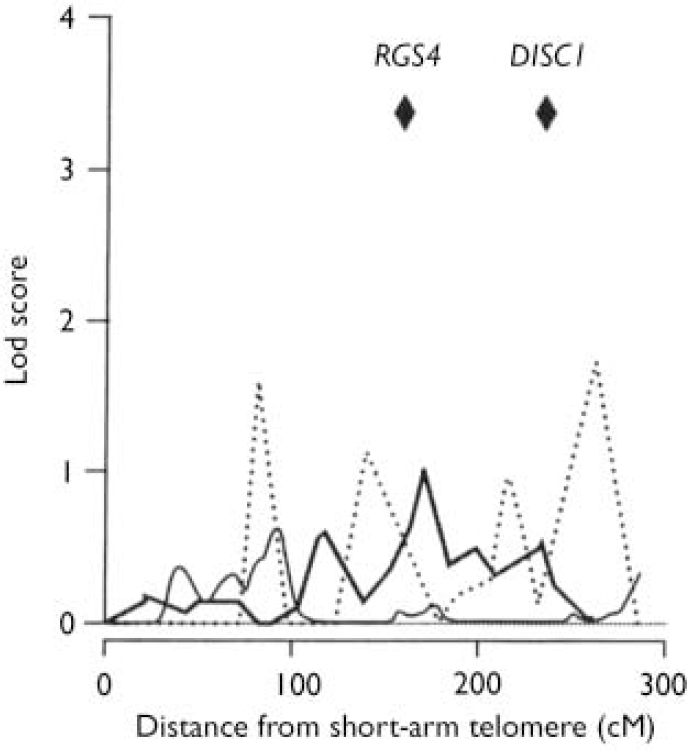In their editorial on chromosomal abnormalities and psychosis Muir et al (Reference Muir, Pickard and Blackwood2006) concluded that DISC1 ‘is an important modulator of risk for schizophrenia and severe affective disorder in people without cytogenetic abnormalities and may also influence cognition and brain structure in the general population’. They base their conclusions on work that originated in the finding of a rearrangement between chromosomes 1 and 11 in a single large family with polymorphic psychiatric syndromes (Reference Millar, Christie and AndersonMillar et al, 2001). The two genes (DISC1 and DISC2) that they are concerned with were identified at the breakpoint and by linkage analysis were postulated to be relevant to psychiatric disease within that family.
Muir et al argue that these findings are relevant to schizophrenia in general. However, the evidence is less compelling than they suggest. Figure 1 presents the findings of the three largest linkage studies to date in relation to the location of DISC1 on chromosome 1 (the location of another ‘candidate gene’ RGS4 is also shown). Each study included over 300 sibling pairs with schizophrenia or schizoaffective disorder and each included markers spaced at 10 cM intervals across the genome. The Lod (log of the odds) score is a measure of linkage – transmission of a disease state with particular genetic markers within families – and values above 3 are generally taken as significant evidence for linkage. In these three studies there is no evidence of linkage at the DISC1 locus or elsewhere on chromosome 1. The two claims of linkage made in Table 1 of Muir et al's editorial relate to post hoc subdivision of one of these populations by diagnosis and to a finding in a separate smaller Finnish study. Given the ubiquity of psychosis across populations, and the relative uniformity of incidence of the core syndrome, and in the face of lack of evidence of linkage in populations of over 1000 sibling pairs (Reference CrowCrow, 2007), it is difficult to see that DISC1 can have an ‘important role in the development of psychosis’ as Muir et al argue. The evidence has been overinterpreted.

Fig. 1 Linkage studies of DISC1 in sibling pairs with schizophrenia or schizoaffective disorder.—,Reference DeLisi, Shaw and CrowDeLisi et al, 2002 (382 sibling pairs);….,Reference Williams, Norton and WilliamsWilliams et al,2003 (353 sibling pairs);—, Reference Suarez, Duan and SandersSuarez et al, 2006 (409 sibling pairs).




eLetters
No eLetters have been published for this article.